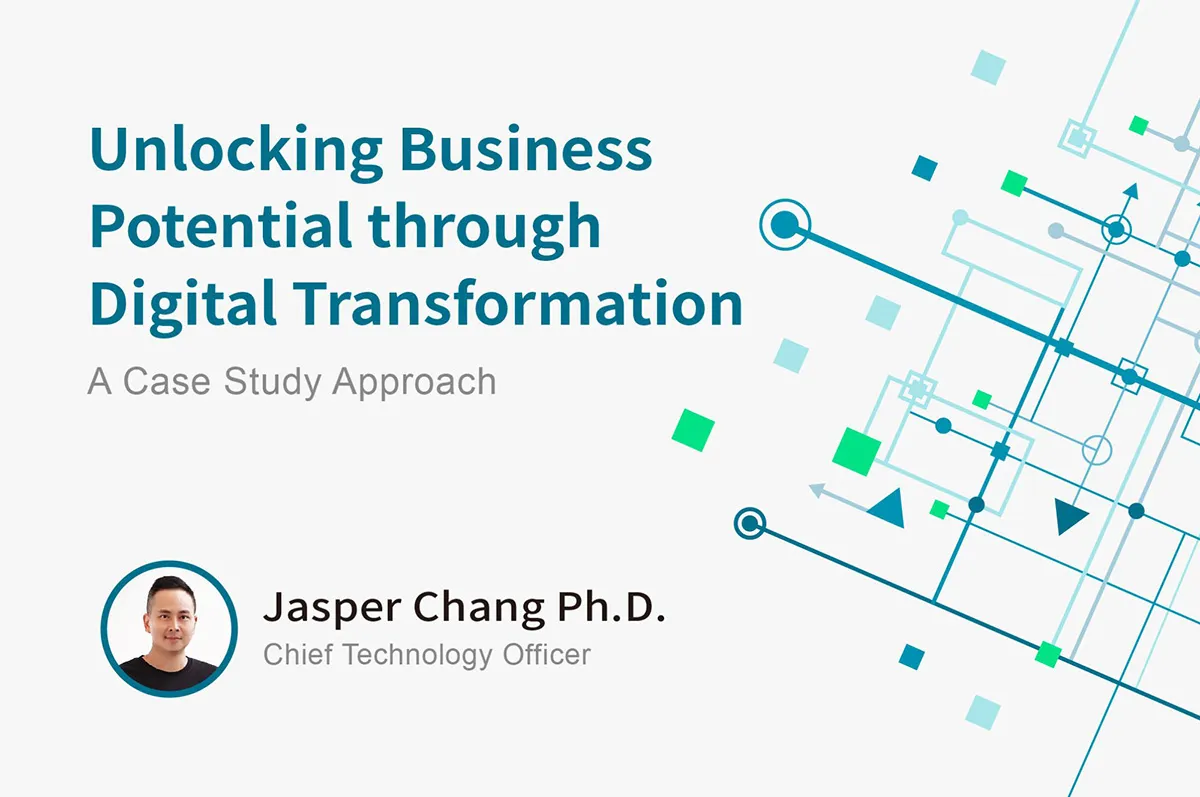
Unlocking Business Potential through Digital Transformation
At a recent gathering, I chatted with a company’s boss who shared the difficulties he encountered in the digital transformation process.
“Our company is currently in the expansion phase, with offices spread across Taipei, Taichung, and Tainan. However, as the business grows, I need to manage and monitor more work progress simultaneously, which sometimes feels very time-consuming.”
His experience reminded me of similar problems faced by many other companies undergoing digital transformation. To solve these problems, I began discussing possible solutions with him.
“Are you using digital tools to assist in coordination and communication?” I asked.
He said, “We primarily use online meeting tools because our office locations are scattered. It is currently the most convenient and quickest solution for us.”
“Besides online meetings, have you ever considered automating some processes to improve work efficiency among colleagues using software?” I further inquired.
“We had a colleague research it before, planning to establish a ‘war room’ that would gather data from all offices within a dashboard. However, the progress was interrupted due to a busy workload.”
To keep up with the trend of digital transformation, companies usually start with top-down decision-making by senior executives. Ideally, digital transformation can improve work efficiency, reduce costs, and collect data for optimizing business strategies, etc. However, this top-down approach can easily create a gap when implemented at the operational level.
Whether it’s because of changing existing work patterns, increasing work (requiring previously unused software systems), or worrying about jobs being replaced by software, these could all be obstacles in the company’s transformation process. They might fail to achieve the managerial level’s expected results, but this is not necessarily an issue with the software system itself.
So, companies like us, which are software consulting firms, step in to help enterprises understand the different user needs within the company. After understanding the business owner’s goals, we assist in implementing digital transformation internally using new digital tools. The digital transformation discussed here usually includes three phases: 1. Digitization, 2. Digital Optimization, 3. Digital Transformation.
Digitization
Many traditional enterprises record information on paper rather than through integrated computer systems during their operations. This process is not only time-consuming and wasteful of manpower but also raises security concerns.
From the perspective of Cloud-Interactive, many clients are progressing towards digitization. Colleagues in these client companies are very accustomed to using common office software. When the company has fewer than 10 employees, communication can still be managed through manpower via email and file attachments. However, when the organization has more than 40 or 50 people, issues such as lost files, unhandled handovers, or new work content without notifications often occur. This leads to internal colleagues having to hold continuous meetings, consuming valuable human resources.
Therefore, the first step in digital transformation is to introduce a digital web system to manage most of the paper-based information digitally. With over 10 years of experience in digital system development through Cloud-Interactive, past paper-based and form data is converted into a digital system.
Real Cases:
Case 1: A large financial holding group has files from multiple companies within it. In response to regulatory requirements, they needed a new system. After understanding the client’s needs, Cloud-Interactive proposed a management system plan with file permission control. This allows authorized service personnel to search for the customer data they need within the system, and also allows managers to effectively control access to each piece of data, ensuring company information security.
Case 2: A small-to-medium-sized furniture trading company’s internal staff need to handle quotes and shipping orders. Previously, this was done using common Excel methods, often requiring repetitive operations. Through Cloud-Interactive’s customized quote system, clients can follow their familiar existing procedures paired with modern web systems, quickly enhancing the company’s operational efficiency.
Digital Optimization
Digital optimization is the current development phase for the majority of businesses in Taiwan. The main focus is to efficiently utilize the data and information that exists in digital systems after a company has undergone digitization. Further refining work processes through data organization and analysis, and integrating these with existing business models, helps to improve efficiency and elevate the quality of products/services.
Some companies have already introduced digital software or website systems earlier on, but as times have changed, so have many business processes. At the same time, many new needs can no longer be met with the original software systems, causing a bottleneck in company development.
At this point, the best strategy would be to reorganize the current business processes within the company. Break down key functional systems and optimize each process step-by-step. Avoid trying to get it perfect in one go; according to our experience from over hundreds of development projects, it’s usually more effective to start with partial optimization. This allows for synchronous updates of workflows within the organization, in tandem with software development, ultimately yielding results that align with management expectations.
Real Cases:
Case 1: A large tech company’s existing system has been in use for over 10 years. Many data layers are stacked like a house of cards, but the database itself is complex and difficult to adjust. Through user interviews, Cloud-Interactive helps the client to organize data types. A systematic design vocabulary is used to plan a complete interface and data flow, making it easier for the client to search for different types of data, improve the customer experience, reduce communication costs, and enhance the company’s overall performance.
Case 2: A large hardware distributor initially had a system that was not web-based. Only specific personnel were familiar with system operations. As more and more marketing activities were needed, the original system could no longer meet the flexible requirements of marketing staff. Through complete User Experience Design (UI/UX), Cloud-Interactive organizes complex types of marketing activities and systematically plans them into the interface, greatly enhancing the convenience for clients to operate marketing activities.
Digital Transformation
“Digital Transformation” is built upon the foundation of digitalization and digital optimization. It involves using “digital systems” combined with changes in the “business model” to solve problems for enterprises. However, to keep up with the evolution of the times and the need for innovation, the strategic means go beyond simply adopting new technology. It is also about “changing the business logic of the enterprise” and “enhancing the organization’s cultural mindset.”
Real Cases:
Case 1: A well-known multinational esports company has decent hardware sales performance in major markets like Europe and America. However, their past software development was decoupled from hardware, failing to provide an integrated software-hardware experience. In this case, Cloud-Interactive not only helped the client plan software development projects but also offered innovative product designs that capture consumer attention in the highly competitive esports industry. Furthermore, we provide end-to-end services from design to development, offering practical recommendations to save clients from wasting time and budget.
Case 2: A nationally renowned engineering company initiated a digital transformation project a few years ago. In this case, the senior executives at the headquarters hoped to improve engineering quality control through the establishment of software and Apps, and in the future, they hope to use the stored data for predictive data analytics applications. However, front-line engineers, who were busy with ongoing projects, found that assisting the company in “data organization” added to their workload without producing noticeable outcomes in the short term.
Thus, Cloud-Interactive allocated a period for “user research” at the beginning of the project, engaging with front-line engineers to understand the documentation and graphic data they deal with during quality checks. Previously, much time was spent organizing scattered files across various platforms, leading to incomplete data aggregation and even errors.
After understanding the overall workflow, Cloud-Interactive’s design and development team created a digital process for quality checks, helping them integrate data and photos and quickly generate documents. This not only made engineers more willing to use it but also met the objectives of the management layer.
Summary
The trend towards digitalization is well-known. In the past, the hard-working people of Taiwan and abundant labor resources managed manual operations. However, under the dual challenges of globalization and declining birth rates, achieving effective digital transformation is not easy for enterprises.
Cloud-Interactive has a professional team with over 15 years of experience in software design and development. From helping organizations focus on business goals to software design, development, environment setup, and post-launch maintenance, we can provide your enterprise with more efficient digital transformation tools. If you have any concerns about digital transformation and need complete, customized software services, please contact the sales representatives of Cloud-Interactive here.
We hope today’s article helps enterprises looking to undergo digital transformation. See you next time!
By Cloud Interactive
Meet the masterminds behind the curtain at Cloud Interactive. We're not just software developers - we're also a content crew fuelled by caffeine and a thirst for knowledge. We translate tech jargon into plain English, dissect industry trends, and craft helpful tips that are informative and engaging. So, buckle up and join us on a journey through the ever-evolving and exciting world of technology!


